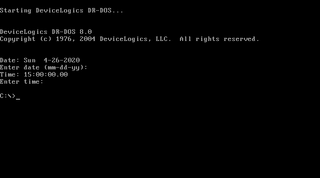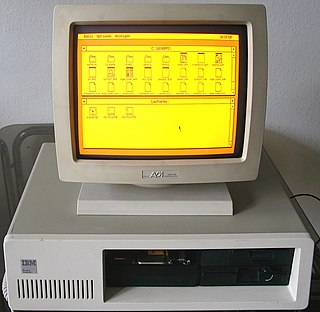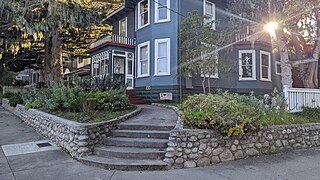
DR-DOS is a disk operating system for IBM PC compatibles. Upon its introduction in 1988, it was the first DOS that attempted to be compatible with IBM PC DOS and MS-DOS.

GEM is a discontinued operating environment released by Digital Research in 1985. GEM is known primarily as the native graphical user interface of the Atari ST series of computers, providing a WIMP desktop. It was also available for IBM PC compatibles and shipped with some models from Amstrad. GEM is used as the core for some commercial MS-DOS programs, the most notable being Ventura Publisher. It was ported to other computers that previously lacked graphical interfaces, but never gained traction. The final retail version of GEM was released in 1988.

Digital Research, Inc. was a privately held American software company created by Gary Kildall to market and develop his CP/M operating system and related 8-bit, 16-bit and 32-bit systems like MP/M, Concurrent DOS, FlexOS, Multiuser DOS, DOS Plus, DR DOS and GEM. It was the first large software company in the microcomputer world. Digital Research was originally based in Pacific Grove, California, later in Monterey, California.

Novell, Inc. was an American software and services company headquartered in Provo, Utah, that existed from 1980 until 2014. Its most significant product was the multi-platform network operating system known as Novell NetWare.
Star Trek is the code name that was given to a secret prototype project, running a port of Macintosh System 7 and its applications on Intel-compatible x86 personal computers. The project, starting in February 1992, was conceived in collaboration between Apple Computer, who provided the majority of engineers, and Novell, who at the time was one of the leaders of cross-platform file-servers. The plan was that Novell would market the resulting OS as a challenge to Microsoft Windows, but the project was discontinued in 1993 and never released, although components were reused in other projects. The project was named after the Star Trek science fiction franchise with the slogan "To boldly go where no Mac has gone before".
DataFlex is an object-oriented high-level programming language and a fourth generation visual tool for developing Windows, web and mobile software applications on one framework-based platform. It was introduced and developed by Data Access Corporation beginning in 1982.
In a series of legal disputes between SCO Group and Linux vendors and users, SCO alleged that its license agreements with IBM meant that source code IBM wrote and donated to be incorporated into Linux was added in violation of SCO's contractual rights. Members of the Linux community disagreed with SCO's claims; IBM, Novell, and Red Hat filed claims against SCO.

ViewMAX is a CUA-compliant file manager supplied with DR DOS versions 5.0 and 6.0. It is based on a cut-down runtime version of Digital Research's GEM/3 graphical user interface modified to run only a single statically built application, the ViewMAX desktop. Support for some unneeded functions has been removed whilst some new functions were added at the same time. Nevertheless, the systems remained close enough for ViewMAX to recognize GEM desktop accessories automatically and to allow some native GEM applications to be run inside the ViewMAX environment. Many display drivers for GEM 3.xx could be used by ViewMAX as well, enabling ViewMAX to be used with non-standard display adapters and higher resolutions than possible using the default set of ViewMAX drivers. Also, Digital Research's SID86, the symbolic instruction debugger that shipped with DR DOS 3.xx and provided dedicated functions to debug GEM applications, could be used for ViewMAX as well.
Virtual DOS machines (VDM) refer to a technology that allows running 16-bit/32-bit DOS and 16-bit Windows programs when there is already another operating system running and controlling the hardware.
Lineo was a thin client and embedded systems company spun out of Caldera Thin Clients by 20 July 1999.
Merge is a software system which allows a user to run DOS/Windows 3.1 on SCO UNIX, in an 8086 virtual machine.

Arachne is an Internet suite containing a graphical web browser, email client, and dialer. Originally, Arachne was developed by Michal Polák under his xChaos label, a name he later changed into Arachne Labs. It was written in C and compiled using Borland C++ 3.1. Arachne has since been released under the GPL as Arachne GPL.
Caldera OpenLinux (COL) is a defunct Linux distribution. Caldera originally introduced it in 1997 based on the German LST Power Linux distribution, and then taken over and further developed by Caldera Systems since 1998. A successor to the Caldera Network Desktop put together by Caldera since 1995, OpenLinux was an early "business-oriented distribution" and foreshadowed the direction of developments that came to most other distributions and the Linux community generally.
FlexOS is a discontinued modular real-time multiuser multitasking operating system (RTOS) designed for computer-integrated manufacturing, laboratory, retail and financial markets. Developed by Digital Research's Flexible Automation Business Unit in Monterey, California, in 1985, the system was considered to become a successor of Digital Research's earlier Concurrent DOS, but with a new, modular, and considerably different system architecture and portability across several processor families. Still named Concurrent DOS 68K and Concurrent DOS 286, it was renamed into FlexOS on 1 October 1986 to better differentiate the target audiences. FlexOS was licensed by several OEMs who selected it as the basis for their own operating systems like 4680 OS, 4690 OS, S5-DOS/MT and others. Unrelated to FlexOS, the original Concurrent DOS system architecture found a continuation in successors like Concurrent DOS XM and Concurrent DOS 386 as well.

Windows 3.1 is a major release of Microsoft Windows. It was released to manufacturing on April 6, 1992, as a successor to Windows 3.0.
The Zinc Application Framework is an application framework, intended for the development of cross-platform software applications with graphical user interface (GUI), using a widget toolkit. Zinc targets both embedded and desktop platforms.
Caldera was a US-based software company founded in 1994 to develop Linux- and DOS-based operating system products.
DOS Protected Mode Services (DPMS) is a set of extended DOS memory management services to allow DPMS-enabled DOS drivers to load and execute in extended memory and protected mode.

DR-WebSpyder is a DOS web browser, mail client and operating system runtime environment that was developed by Caldera UK in 1997. It was based on the DR-DOS operating system and networking components from Novell as well as the Arachne web browser by Michal Polák of xChaos software. The system was designed to run on low-end desktop systems, but being able to boot and execute from disk as well as from ROM or network, it was also tailored for x86-based thin clients and embedded systems with or without disk drives. Using the web browser as its principal user interface, it could be also used for kiosk systems and set-top boxes. It was ported to Linux in 1999 under the name Embrowser and was renamed Embedix Browser in 2000.








